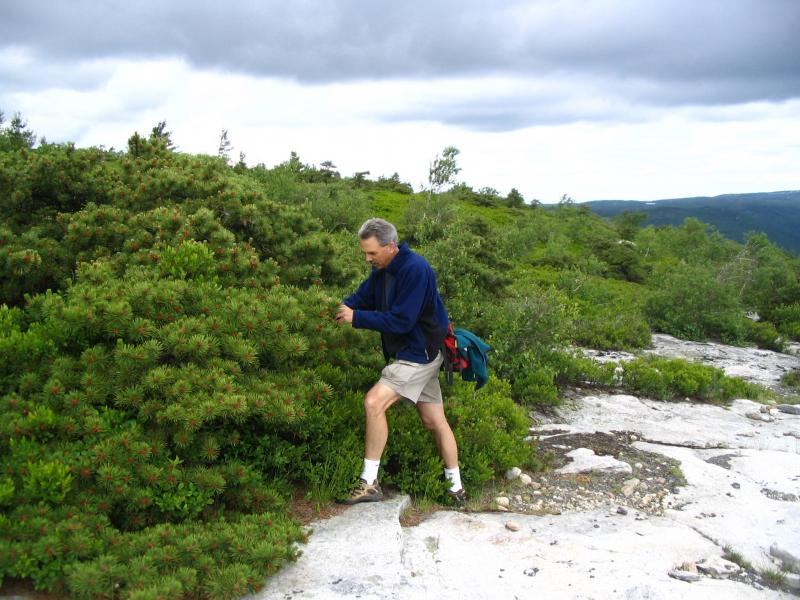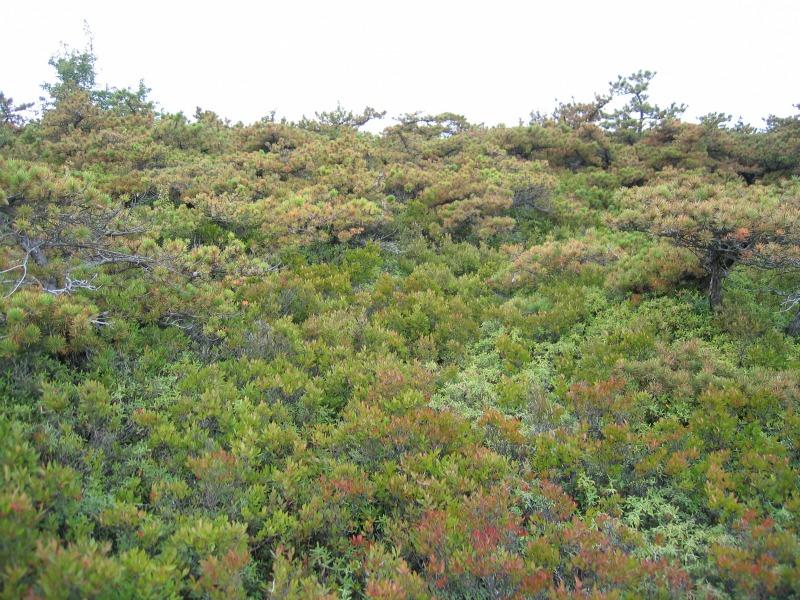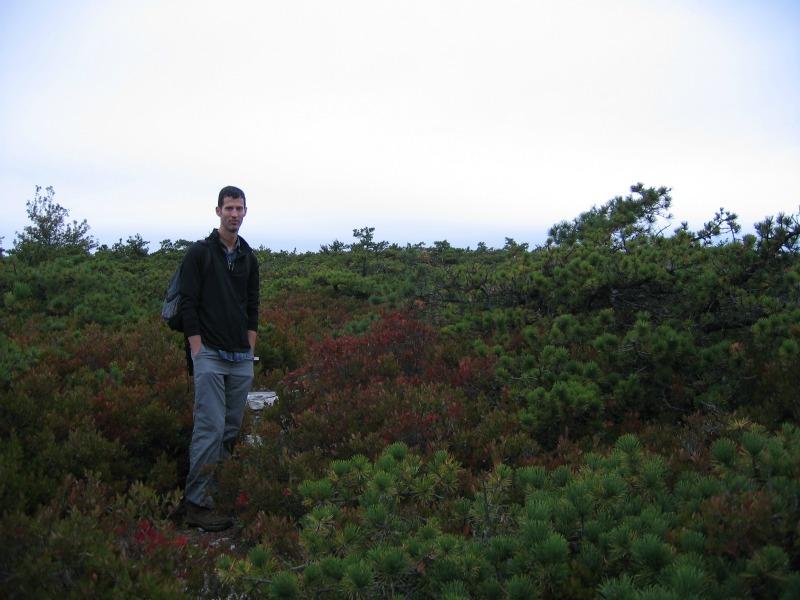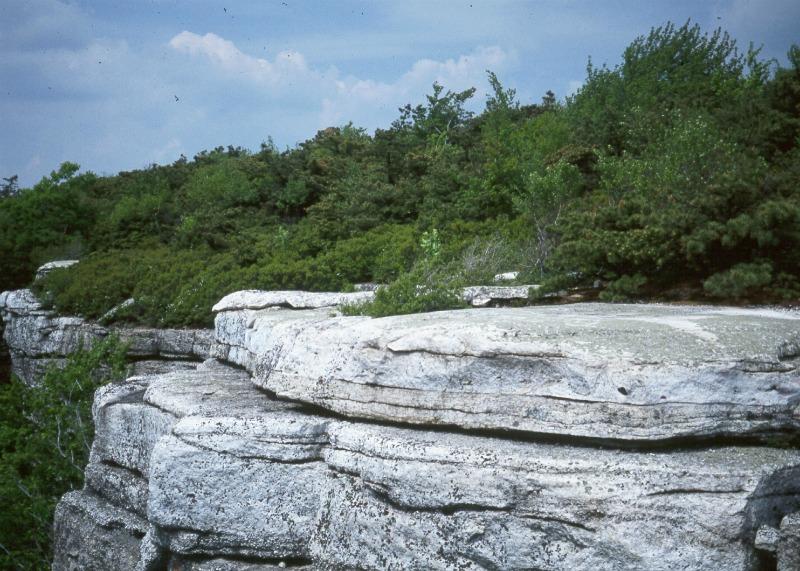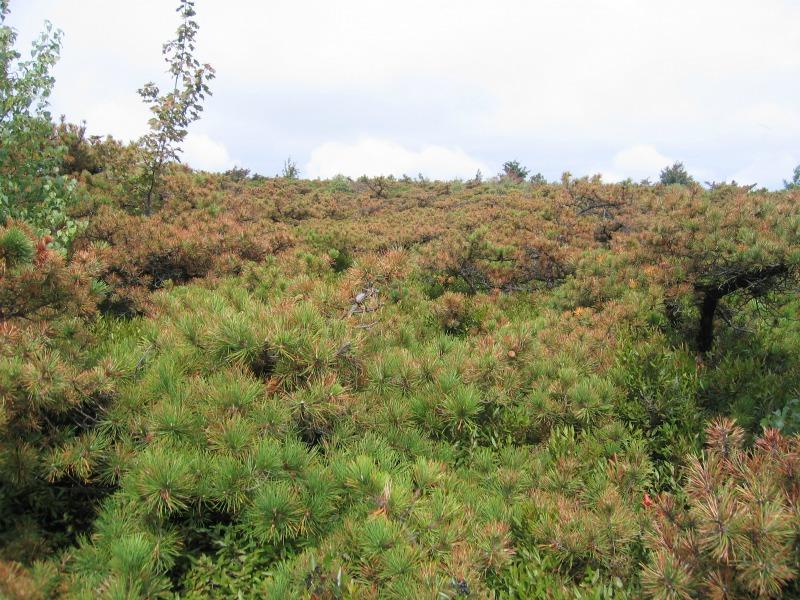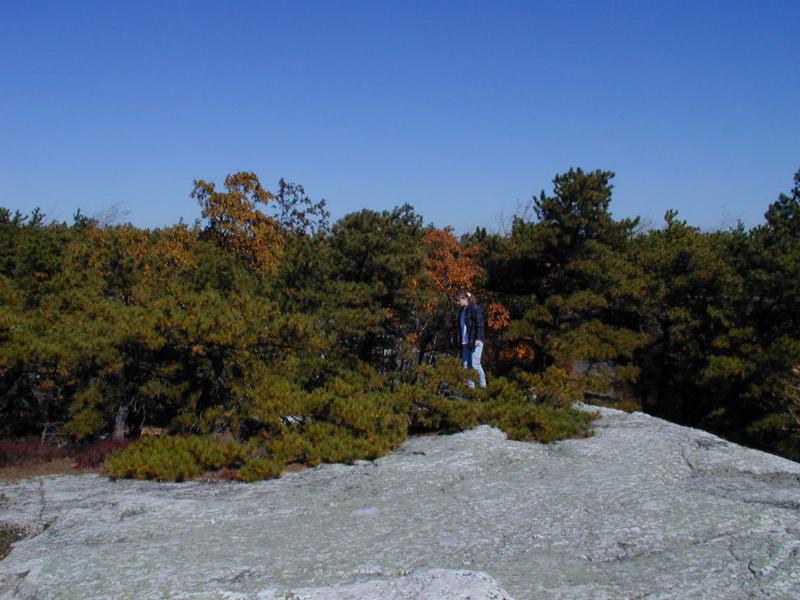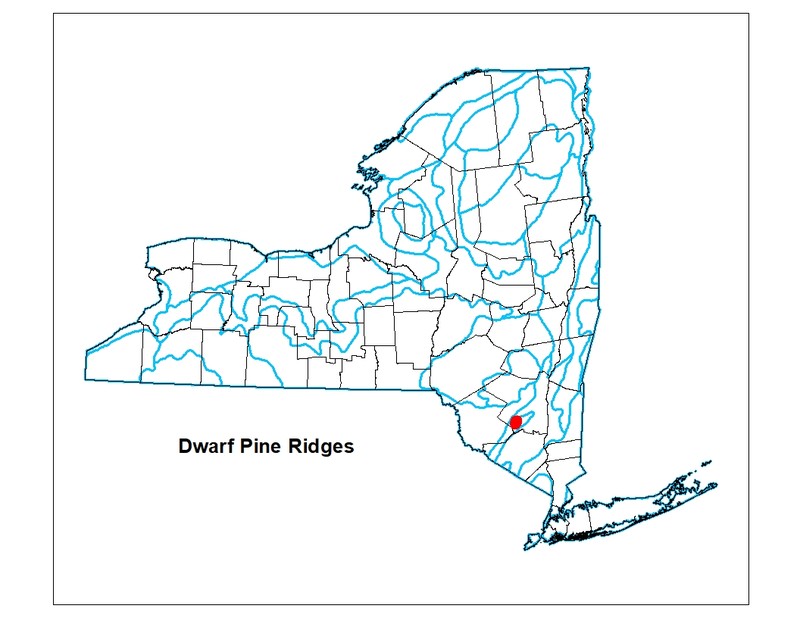Dwarf Pine Ridges
- System
- Terrestrial
- Subsystem
- Barrens And Woodlands
- State Protection
- Not Listed
Not listed or protected by New York State.
- Federal Protection
- Not Listed
- State Conservation Status Rank
- S1
Critically Imperiled in New York - Especially vulnerable to disappearing from New York due to extreme rarity or other factors; typically 5 or fewer populations or locations in New York, very few individuals, very restricted range, very few remaining acres (or miles of stream), and/or very steep declines.
- Global Conservation Status Rank
- G1G2
Critically Imperiled or Imperiled globally - At very high or high risk of extinction due to rarity or other factors; typically 20 or fewer populations or locations in the world, very few individuals, very restricted range, few remaining acres (or miles of stream), and/or steep declines. More information is needed to assign either G1 or G2.
Summary
Did you know?
Dwarf pine ridges are a unique and globally rare natural community that are only known from the the Northern Shawangunk Mountains. The community is dominated by dwarf individuals of pitch pine, which require fire to regenerate. Pitch pine cones are serotinous, which means they require fire to open. Unlike other pine cones, which open in the fall and distribute seeds, pitch pine cones stay closed until heat from fire opens the them and distributes the seeds. The fire creates an excellent bed of nutrient-rich soil for the seeds to germinate. Pitch pines are adapted to fire in other ways as well. Even though large branches may die in a fire, their thick trunk survives and produces new branches.
State Ranking Justification
This community is restricted to outcrops of Shawangunk Conglomerate at Sam's Point in the Northern Shawangunk Mountains in Ulster County. Sam's Point appears to be the only occurrence of dwarf pine ridges, as described by New York Natural Heritage (Edinger et al. 2002), in the world.
Short-term Trends
The dwarf pine ridge occurrence at Sam's Point has probably remained stable in its condition and size in recent decades due to the protection efforts of conservation partners.
Long-term Trends
The dwarf pine ridges are under public and private conservation ownership and well-protected. Implementing the prescribed burn plan will likely improve the long-term viability of this community.
Conservation and Management
Threats
Dwarf pine ridges are threatened by development (especially plans for cellular telephone and radio towers, wind farms, etc.) and trampling by recreational visitors (e.g., mountain bikers, hikers). These threats have been greatly reduced as a result of protection efforts by conservation partners. The natural fire regime (e.g., from lightning strikes) has been suppressed in the past, but implementing a prescribed burn plan will likely improve the long-term viability of this community. Southern pine beetle (Dendroctonus frontalis) is a bark beetle that infests pine trees, such as pitch pine, white pine, and red pine. Southern pine beetle is native to the southeastern United States, but its range has spread up the east coast to Long Island, New York in 2014. Natural communities dominated or co-dominated by pines would likely be most impacted by southern pine beetle invasion.
Conservation Strategies and Management Practices
Management activities should include the development and implementation of a prescribed burn plan for Sam's Point. Fragmenting features such as roads, abandoned tower clearings, and unnecessary trails should be reduced or minimized, and high-impact activities, such as the use of mountain bikes and ATVs, should be restricted. Prevent the dumping of trash via signage at susceptible areas, and by implementing regular patrols.
Development and Mitigation Considerations
Soils are very thin in and around this community and the effect of clearing and construction on soil retention and erosion must be considered during any development activities. Similarly, these soils are acidic and nutrient-poor and any soil enrichment activities (septic leach fields, fertilized lawns, etc.) have a high probability of altering community structure and function. The pitch pine-dominated structure of this community is maintained by fire and presents a fire hazard to existing and proposed development. Unprotected structures located within or near this community are more susceptible to damage from wild fire.
Inventory Needs
Determine if dwarf pine ridges, as described by New York Natural Heritage (Edinger et al. 2002), occur in other northeast states (e.g., MA, CT, NJ, PA). Preliminary investigations suggest that sites with stunted pitch pine mixed with oak in other states are not this community (e.g., Mount Everett, MA; Panther Knob, WV). Other ridges in New York with lesser amounts of stunted pitch pine are generally better classified as pitch pine-oak-heath rocky summit.
Research Needs
Determine if Sam's Point is the only global occurrence of dwarf pine ridges as described by New York Natural Heritage (Edinger et al. 2002). Determine the optimal fire regime for this community. Increase the confidence in the classification and the delineation of dwarf pine ridges from pitch pine-oak-heath rocky summit at Sam's Point.
Rare Species
Range
New York State Distribution
This community is restricted to outcrops of Shawangunk Conglomerate at Sam's Point in the Northern Shawangunk Mountains in Ulster County. Sam's Point appears to be the only occurrence of dwarf pine ridges, as described by New York Natural Heritage (Edinger et al. 2014), in the world.
Global Distribution
This community is restricted to outcrops of Shawangunk Conglomerate at Sam's Point in the Northern Shawangunk Mountains in Ulster County. Sam's Point appears to be the only occurrence of dwarf pine ridges, as described by NY Natural Heritage (Edinger et al. 2002), in the world. Preliminary investigations suggest that sites with with stunted pitch pine mixed with oak in other states are not this community (e.g., Mount Everett, MA; Panther Knob, WV). Other ridges in the northeast with lesser amounts of stunted pitch pine are generally better classified as pitch pine-oak-heath rocky summit.
Best Places to See
- Sam's Point Dwarf Pine Ridge Preserve (Ulster County)
- Minnewaska State Park Preserve (Ulster County)
Identification Comments
General Description
Dwarf pine ridges are woodlands dominated by pitch pine (Pinus rigida) trees that are less than 5 m (16 feet) tall. They occur over thin soils on flat-topped rocky ridges of white quartzite conglomerate. The understory is well developed, with a shrub layer dominated by black huckleberry. Other understory associates that may be present include lowbush blueberry (Vaccinium angustifolium, V. corymbosum), black chokeberry (Photinia melanocarpa), sheep laurel (Kalmia angustifolia), wintergreen (Gaultheria procombens), and sweet-fern (Comptonia peregrina).
Characters Most Useful for Identification
A dwarf woodland dominated by pitch pine and black huckleberry, occuring on flat-topped summits of rocky ridges. Other understory associates that may be present include lowbush blueberry, black chokeberry, sheep laurel, wintergreen, and sweet-fern. Large areas may be dominated by a closed canopy of stunted pitch pine (2 to <5 m tall).
Elevation Range
Known examples of this community have been found at elevations between 1,880 feet and 2,283 feet.
Best Time to See
This community is scenic year round. It is impressive to find a high spot and overlook the dwarf pitch pines that blanket the flat summit of Sam's Point. Dense areas of huckleberries and blueberries ripen in the summer and their leaves turn scarlet red in the fall.
Dwarf Pine Ridges Images
Classification
International Vegetation Classification Associations
This New York natural community encompasses all or part of the concept of the following International Vegetation Classification (IVC) natural community associations. These are often described at finer resolution than New York's natural communities. The IVC is developed and maintained by NatureServe.
- Pitch Pine / Broom Crowberry Woodland (CEGL006154)
- Pitch Pine / Black Huckleberry Scrub (CEGL006079)
NatureServe Ecological Systems
This New York natural community falls into the following ecological system(s). Ecological systems are often described at a coarser resolution than New York's natural communities and tend to represent clusters of associations found in similar environments. The ecological systems project is developed and maintained by NatureServe.
- Central Appalachian Pine-Oak Rocky Woodland (CES202.600)
Characteristic Species
-
Trees > 5m
- Acer rubrum var. rubrum (common red maple)
- Betula papyrifera (paper birch)
- Betula populifolia (gray birch)
- Nyssa sylvatica (black-gum, sour-gum)
- Pinus rigida (pitch pine)
- Tsuga canadensis (eastern hemlock)
-
Shrubs 2 - 5m
- Aronia melanocarpa (black chokeberry)
- Betula papyrifera (paper birch)
- Kalmia angustifolia var. angustifolia (sheep laurel, sheep-kill)
- Sassafras albidum (sassafras)
- Vaccinium corymbosum (highbush blueberry)
- Viburnum nudum var. cassinoides (northern wild-raisin)
-
Shrubs < 2m
- Comptonia peregrina (sweet-fern)
- Gaylussacia baccata (black huckleberry)
- Quercus ilicifolia (scrub oak, bear oak)
- Vaccinium angustifolium (common lowbush blueberry)
- Vaccinium pallidum (hillside blueberry)
-
Herbs
- Carex spp.
- Cornus canadensis (bunchberry)
- Cypripedium acaule (pink lady's-slipper)
- Dennstaedtia punctilobula (hay-scented fern)
- Gaultheria procumbens (wintergreen, teaberry)
- Lycopodium spp.
- Maianthemum canadense (Canada mayflower)
- Melampyrum lineare (cow-wheat)
- Pteridium aquilinum ssp. latiusculum (eastern bracken fern)
-
Nonvascular plants
- Polytrichum spp.
Similar Ecological Communities
- Dwarf pine plains
(guide)
Dwarf pine plains are codominated by dwarf pitch pine and scrub oak (Quercus ilicifolia), and are restricted to the level outwash sand and gravel plains of eastern Long Island.
- Pitch pine-heath barrens
(guide)
Pitch pine-scrub oak barrens have full-sized pitch pines with a heath-dominated understory, and they occur on sandy or rocky soils.
- Pitch pine-oak-heath rocky summit
(guide)
The dwarf pine ridge community is dominated by dwarf pitch pine with tree heights less than 5 m (16 feet) tall, that often form a closed canopy. Pitch pine-oak-heath rocky summits are a mix of pitch pine, and tree and shrub oaks with heath shrubs. Although pitch pine-oak-heath rocky summits may have an few stunted pitch pines, they are not dominant, nor do they form a continuous canopy as is seen in dwarf pine ridges.
- Pitch pine-scrub oak barrens
(guide)
Pitch pine-scrub oak barrens have full-sized pitch pines with abundant scrub oak, and they occur on sandy soils of dunes or outwash plains.
- Red pine rocky summit
(guide)
Red pine rocky summits occur on acidic bedrock ridges and are dominated by red pine (Pinus resinosa) with red oak (Quercus rubra) and white pine (Pinus strobus) as possible codominants.
Vegetation
Percent cover
This figure helps visualize the structure and "look" or "feel" of a typical Dwarf Pine Ridges. Each bar represents the amount of "coverage" for all the species growing at that height. Because layers overlap (shrubs may grow under trees, for example), the shaded regions can add up to more than 100%.
Additional Resources
References
Dirig, Robert. 1994. Lichens of pine barrens, dwarf pine plains, and ice cave habitats in the Shawangunk Mountains, New York. Mycotaxon 52(2):523-558.
Edinger, G. J., D. J. Evans, S. Gebauer, T. G. Howard, D. M. Hunt, and A. M. Olivero (editors). 2014. Ecological Communities of New York State. Second Edition. A revised and expanded edition of Carol Reschke’s Ecological Communities of New York State. New York Natural Heritage Program, New York State Department of Environmental Conservation, Albany, NY. https://www.nynhp.org/ecological-communities/
Edinger, Gregory J., D.J. Evans, Shane Gebauer, Timothy G. Howard, David M. Hunt, and Adele M. Olivero (editors). 2002. Ecological Communities of New York State. Second Edition. A revised and expanded edition of Carol Reschke's Ecological Communities of New York State. (Draft for review). New York Natural Heritage Program, New York State Department of Environmental Conservation. Albany, NY. 136 pp.
Grossman, D. H., K. Lemon Goodin, and C. L. Reuss, editors. 1994. Rare plant communities of the conterminous United States: An initial survey. The Nature Conservancy. Arlington, VA. 620 pp.
Huth, Paul C. 1983. Flora of the Shawangunk Mountain pitch pine-bedrock community on lands of the Village of Ellenville. Unpublished paper at the request of Bagdon Environmental Associates, Albany, NY.
Laing, Charles. 1994. Vegetation and fire history of the dwarf pine ridges, Shawangunk Mountains, New York. The Nature Conservancy, Eastern New York Regional Office, Troy, New York.
Motzkin, G., D.A. Orwig, and D.R. Foster. 2002. History and dynamics of a ridgetop pitch pine community. Mount Everett, Massachusetts. Harvard Forest Paper No. 25. Harvard Forest, Harvard University, Petersham, MA.
NatureServe. 2015. NatureServe Explorer: An online encyclopedia of life [web application]. Version 7.1. NatureServe, Arlington, Virginia. Available http://www.natureserve.org/explorer.
New York Natural Heritage Program. 2024. New York Natural Heritage Program Databases. Albany, NY.
Olsvig, L.S. 1980. A comparative study of northeastern Pine Barrens vegetation. Ph.D. dissertation, Cornell University, Ithaca, NY. 479 pp.
Reschke, Carol. 1990. Ecological communities of New York State. New York Natural Heritage Program, New York State Department of Environmental Conservation. Latham, NY. 96 pp. plus xi.
Russell, Emily E.B. 2001. Three centuries of vegetational change in the Shawangunk Mountains. Unpublished report to The Nature Conservancy. Department of Biological Sciences, Rutgers University, Newark, New Jersey.
Selender, M.D. 1980. Increment borings of pitch pine (Pinus rigida Mill., Pinaceae) from sites on the Shawangunk Ridge and the Ramapo Mountains of southeastern New York State: age and growth dynamics. Skenectada 2: 1-9.
Thompson, John. 1996. Vegetation survey of the northern Shawangunk Mountains, Ulster County, New York. The Nature Conservancy, Eastern New York Chapter, Troy, New York.
Links
About This Guide
Information for this guide was last updated on: December 27, 2023
Please cite this page as:
New York Natural Heritage Program. 2024.
Online Conservation Guide for
Dwarf pine ridges.
Available from: https://guides.nynhp.org/dwarf-pine-ridges/.
Accessed July 27, 2024.
